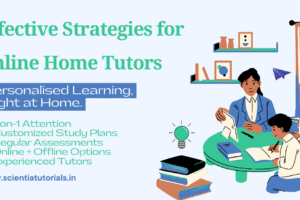Best Practices for Teaching Reading and Writing at Home
Unlocking Literacy: Best Practices for Home Tutors in Teaching Reading and Writing
Introduction
In an increasingly digital world, the ability to read and write proficiently is essential for students’ academic success and personal growth. As home tutors, the role in fostering these skills is paramount, especially in early childhood and elementary education. This article explores best practices for teaching reading and writing at home, equipping tutors with effective strategies to enhance their students’ literacy skills while making the learning experience enjoyable and engaging.
Understanding the Importance of Literacy
The Foundation of Learning
Literacy forms the cornerstone of all academic subjects. Strong reading and writing skills not only enhance comprehension in subjects like math and science but also improve communication skills, critical thinking, and creativity. By developing these skills at an early age, students can build confidence and a love for learning that will serve them throughout their education and beyond.
Lifelong Benefits of Literacy
Literacy is not just about passing exams; it equips students for life. Proficient readers and writers can better navigate daily tasks, participate in community activities, and pursue higher education and employment opportunities. As a home tutor, imparting these skills can have a lasting impact on a student’s future.
Creating a Supportive Learning Environment
Designing an Inviting Space
Setting up a dedicated and comfortable learning environment can significantly influence a student’s engagement and focus. Create a space that is free from distractions and stocked with various reading materials and writing tools. Ensure the area is well-lit and equipped with comfortable seating to encourage prolonged focus.
Establishing a Routine
A consistent tutoring schedule can help students know what to expect, reducing anxiety and making the learning process smoother. Establish a daily or weekly routine that includes time for reading and writing practice, allowing students to become accustomed to regular literacy activities.
Engaging Strategies for Teaching Reading
Phonics and Phonemic Awareness
Phonics instruction is critical for developing reading skills. Teach students the relationship between letters and sounds, focusing on phonemic awareness—the ability to hear and manipulate sounds in words. Use fun activities like rhyming games, sound sorting, and phonics songs to reinforce these concepts.
Building Vocabulary
A robust vocabulary is essential for reading comprehension. Introduce new words in context and encourage students to explore synonyms, antonyms, and word families. Incorporate vocabulary-building games, flashcards, and interactive apps to make learning new words enjoyable.
Reading Aloud
Reading aloud is one of the most effective ways to promote literacy. Choose engaging texts appropriate for the student’s age and interests. As you read, model expressive reading, discuss the story, and encourage students to predict outcomes or relate the story to their own experiences. This interaction not only enhances comprehension but also fosters a love for storytelling.
Using Diverse Reading Materials
Expose students to a variety of reading materials, including fiction, nonfiction, poetry, and graphic novels. Diversifying reading choices helps students find genres they enjoy and can enhance their understanding of different writing styles and formats. Allow students to choose books that interest them, fostering independence and motivation.
Encouraging Independent Reading
Promote independent reading by setting aside time for students to read on their own. Create a reading log where they can record their thoughts about the books they’ve read. Encourage discussions about their reading choices to reinforce comprehension and critical thinking skills.
Effective Writing Instruction Techniques
The Writing Process
Teach students about the writing process, which typically includes prewriting, drafting, revising, editing, and publishing. Breaking the process into manageable steps can make writing less daunting and more organized. Encourage students to brainstorm ideas before writing and to revise their work for clarity and coherence.
Incorporating Writing Prompts
Writing prompts can spark creativity and provide structure. Use engaging prompts related to the student’s interests or current events to encourage them to write. Encourage different types of writing, such as narratives, persuasive pieces, and descriptive writing, to help them explore various styles and formats.
Practice Writing Daily
Establish a routine that includes daily writing practice. This could involve journaling, responding to prompts, or creating short stories. Consistent practice not only builds writing skills but also helps students develop their voice and confidence as writers.
Peer Review and Feedback
Encourage students to share their writing with peers for feedback. This process not only helps them improve their work but also teaches them how to give and receive constructive criticism. Create a supportive atmosphere where students feel comfortable discussing their writing and learning from one another.
Incorporating Technology in Literacy Education
Educational Apps and Tools
Leverage technology to enhance literacy instruction. Numerous educational apps and websites focus on reading and writing skills, offering interactive and engaging exercises. Tools like Storybird for creative writing or Epic! for reading can make learning fun while providing valuable practice.
Online Reading Resources
Introduce students to online libraries and reading resources. Websites like Project Gutenberg and ReadWorks offer access to a vast array of texts suitable for various reading levels. Encouraging students to explore these resources can foster independent learning and a passion for reading.
Using Multimedia
Incorporate multimedia resources, such as videos, audiobooks, and podcasts, into lessons. For example, listening to an audiobook can help students understand narrative structure while enhancing listening skills. Using videos can also introduce them to new vocabulary and concepts in an engaging format.
Monitoring Progress and Adjusting Instruction
Regular Assessment
Regularly assess students’ reading and writing abilities to identify strengths and areas for improvement. Use a mix of formal assessments, such as quizzes and tests, and informal assessments, like observations and discussions, to gauge progress. Tailor instruction based on these assessments to ensure that students receive the support they need.
Setting Goals
Collaboratively set achievable literacy goals with students. Goals should be specific, measurable, attainable, relevant, and time-bound (SMART). Celebrate milestones to motivate students and encourage them to take ownership of their learning journey.
Adapting to Individual Needs
Every student learns at their own pace. Be prepared to adapt instruction to meet individual needs, whether that means providing additional resources for struggling readers or offering advanced materials for those who are excelling. Flexibility in teaching methods ensures that all students are appropriately challenged and supported.
Building Confidence and Motivation
Creating a Positive Atmosphere
A positive learning environment is crucial for building student confidence. Encourage a growth mindset by emphasizing effort over perfection. Remind students that making mistakes is a part of the learning process and that persistence leads to improvement.
Celebrating Achievements
Acknowledge and celebrate students’ achievements, no matter how small. Providing positive reinforcement can boost motivation and confidence. Consider using rewards, certificates, or simple praise to recognize their hard work and progress.
Involving Families in Literacy Activities
Encourage families to participate in literacy activities at home. Provide parents with strategies and resources to support their children’s reading and writing development. Family involvement fosters a collaborative approach to learning and reinforces the importance of literacy in everyday life.
Conclusion
Teaching reading and writing at home is a rewarding yet challenging endeavor. By employing best practices that focus on creating a supportive environment, using engaging strategies, and fostering a love for literacy, home tutors can significantly impact their students’ academic success and personal development. Ultimately, the goal is to empower students with the skills they need to navigate the world confidently and effectively. By following these strategies, tutors can transform the teaching and learning experience, making literacy an enjoyable journey rather than a daunting task.



